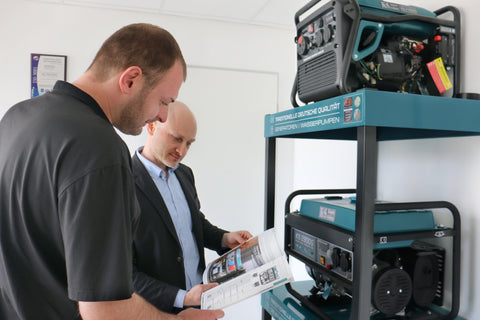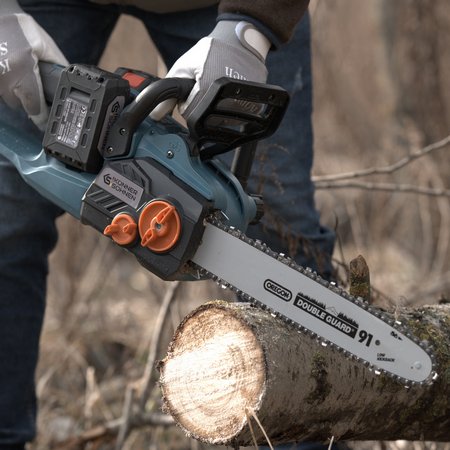The article is protected by copyright. Publishing the entire article or its parts without a clear reference to the source (a link to the Könner & Söhnen website) is not permitted.
Gasoline generators with Schuko and CEE sockets with PE position on 6h are designed as an IT system and have basic protection through the isolation of the active conductors. The PE pins in the sockets are connected to the frame of the generator in the same way as the ground screw. Active L and N lines are isolated from the generator frame.
Build TN system with the generator
The emergency power supply in buildings must usually be provided as a TN system. In this case, the generator and its neutral conductor must be grounded. The ground screw on the generator must be connected to the main ground bar in the house with a 6-10 mm² copper cable. If this is missing, you have to build a grounding for the generator. The PE conductor from the socket on the generator goes to the ground screw in the distribution box, which in turn must be connected to the main ground bar. The N conductor from the generator socket must be grounded at the connection point in the distribution box. This can be done by placing a bridge between N and PE on the generator side of the switch.
The cable to the building is considered the generator output and the TN system is only created when the generator is connected to the building.
Operating the generator with bridged N and PE conductors without grounding is prohibited for personal safety reasons.
The generator itself remains an IT system and can therefore be used mobile without any problems. If you want to supply a house with it, you connect the generator to the earthing, lay the cable from the generator to the power inlet and the system is ready for operation.
Do my electricity consumers need 230V or 400V?
400V three-phase current is usually only required by devices that require a rotating field. These are power consumers with 3-phase motors such as tools, pumps, etc.
Electricity consumers such as electric stoves, powerful instantaneous water heaters, fan heaters, electric boilers or sauna are connected to 3-phases only for the purpose of load distribution in the public grid and are in fact 230V electricity consumers that can be supplied by a 230V generator.
When connected to the public power grid, 230V consumers with a total power of over 4.6 kVA must be connected to three phases to distribute the load. During emergency power operation with a generator that is not designed for unbalanced loads, these consumers should be supplied with 230V, but not at full power, to avoid overloading the neutral conductor.
Such power consumers such as the electric stove are usually connected with a 5 x 2.5 mm² copper cable and so when operating from the generator, a pair of cooking zone, or the electric oven can be operated without any problems without the neutral conductor of the supply cable being overloaded. Provided the generator has enough power for this. The same applies to instantaneous water heaters, fan heaters, electric boilers, saunas etc. which have 230V heating elements internally and are in fact 230V power consumers.
Recommended connection plan in accordance with the VDN guidelines for planning, construction and operation of systems with emergency power generators for 230V models and 1/3 models with VTS in 230V mode:

Emergency power feed-in with a 1-phase house connection:

Emergency power feed-in via the power inlet on the outside wall:

This connection variant requires much less effort than a permanent installation of the generator, which only has advantages in the event of rare power outages.
A changeover switch is installed in the house distribution and a TN system is built on the generator side (bridge between N and PE). In the event of a body short (L against the power consumer housing), the current flows across the bridge from PE to N and the circuit braker on the generator is triggered. The generator ground screw must be connected either to house ground via the pre-installed grounding point or to a purpose-built earthing. The generator can be connected to the power inlet using a standard extension cable (suitable for the socket type). You don't need a permanent installation; the generator is only used in the event of a power outage and can be connected at any time without much effort.
Start the generator manually and check the voltage parameters. The frequency is regulated by the engine speed and can be in the range of 50 to 53Hz. If necessary, this can be readjusted using the speed adjustment screw.
Switch the power supply in the house to the emergency generator using the changeover switch. When power returns from the public grid, switch the changeover switch to the public grid. The generator may be stopped.
The 100-200W ohmic load (e.g. 2 x 100W light bulbs or IR light bulbs) is used to compensate for the non-linear small current consumers in a household such as routers, satellite switches, cell phone chargers, LED lighting, etc., which are only part of the consume sine wave and thus distort the voltage. It is important to avoid harmful harmonics for the electricity consumers at the moment when such electricity consumers are active alone in the house.
The ohmic load loads the parts of the sine curve of the voltage that are not loaded by non-linear electronic current consumers and thereby dampens the harmonics.
Voltage (yellow) and current (green) from a conventional generator under electronic load with and without ohmic load (100W light bulb):


You can see that the disturbing harmonics marked with the red arrows in the left picture are much smaller in the right picture and most electronic modules then work without any problems.
Könner & Söhnen generators with a VTS system can be used to power both 230V and 400V power consumers, but not at the same time. The 400V mode is exclusively for 400V three-phase consumers that load all 3 phases symmetrically.

When switching from 230V to 400V mode and vice versa, you must first switch off the load, change the mode, check the voltage and only then switch on the load.
Models KS 7000E-3 and KS 10000E-3 deliver 400V and are intended for 400V power consumers that load all 3-phases symmetrically and are not suitable for a complete house feed with mixed 230V and 400V power consumers.

The 230V socket is connected in parallel to one phase of the 400V 16A CEE socket and may only be loaded moderately so that the total unbalanced load does not exceed 20%. However, the 230V socket may be loaded with up to a third of the generator's total output if no load is connected to the 400V socket. The voltages at L2 and L3 come from the 230V +/- 10% tolerance range and must not be used.
Not suitable for sensitive power consumers!
In conventional generators (also with AVR), the current is taken from the alternator winding and the shape of the voltage can differ from the sine wave depending on the design of the generator and the connected power consumers. The frequency of the voltage in a conventional synchronous generator is determined by the speed of the motor, which can fluctuate depending on the load. The value of 50-53 Hz is permissible and is within the tolerance range.
You must ask the manufacturer of the device to be powered by the generator in question whether you can use a conventional generator to power this devices, as this may solely be due to the design of the device in question.
The generators described in this article are emergency generators and are not suitable for continuous, continuous operation.
We recommend running all of our gasoline generators for up to 5-6 hours (depending on load and outside temperature), but then taking a break of 30-60 minutes to cool down.
Disclaimer:
These instructions can only be perceived as a recommendation, are descriptive and must be adapted to the exact circumstances and conditions on site during installation. The installation itself should be carried out in compliance with all standards and regulations. We assume no responsibility for incorrect installations and their consequences.







